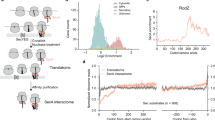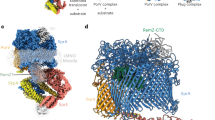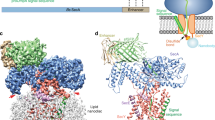Abstract
Extra-cytoplasmic polypeptides are usually synthesized as ‘preproteins’ carrying amino-terminal, cleavable signal peptides1 and secreted across membranes by translocases. The main bacterial translocase comprises the SecYEG protein-conducting channel and the peripheral ATPase motor SecA2,3. Most proteins destined for the periplasm and beyond are exported post-translationally by SecA2,3. Preprotein targeting to SecA is thought to involve signal peptides4 and chaperones like SecB5,6. Here we show that signal peptides have a new role beyond targeting: they are essential allosteric activators of the translocase. On docking on their binding groove on SecA, signal peptides act in trans to drive three successive states: first, ‘triggering’ that drives the translocase to a lower activation energy state; second, ‘trapping’ that engages non-native preprotein mature domains docked with high affinity on the secretion apparatus; and third, ‘secretion’ during which trapped mature domains undergo several turnovers of translocation in segments7. A significant contribution by mature domains renders signal peptides less critical in bacterial secretory protein targeting than currently assumed. Rather, it is their function as allosteric activators of the translocase that renders signal peptides essential for protein secretion. A role for signal peptides and targeting sequences as allosteric activators may be universal in protein translocases.
This is a preview of subscription content, access via your institution
Access options
Subscribe to this journal
Receive 51 print issues and online access
$199.00 per year
only $3.90 per issue
Buy this article
- Purchase on Springer Link
- Instant access to full article PDF
Prices may be subject to local taxes which are calculated during checkout




Similar content being viewed by others
References
Blobel, G. & Dobberstein, B. Transfer of proteins across membranes. I. Presence of proteolytically processed and unprocessed nascent immunoglobulin light chains on membrane-bound ribosomes of murine myeloma. J. Cell Biol. 67, 835–851 (1975)
Rapoport, T. A. Protein translocation across the eukaryotic endoplasmic reticulum and bacterial plasma membranes. Nature 450, 663–669 (2007)
Papanikou, E., Karamanou, S. & Economou, A. Bacterial protein secretion through the translocase nanomachine. Nature Rev. Microbiol. 5, 839–851 (2007)
Gelis, I. et al. Structural basis for signal-sequence recognition by the translocase motor SecA as determined by NMR. Cell 131, 756–769 (2007)
Hartl, F. U., Lecker, S., Schiebel, E., Hendrick, J. P. & Wickner, W. The binding cascade of SecB to SecA to SecY/E mediates preprotein targeting to the E. coli plasma membrane. Cell 63, 269–279 (1990)
Zhou, J. & Xu, Z. The structural view of bacterial translocation-specific chaperone SecB: implications for function. Mol. Microbiol. 58, 349–357 (2005)
Schiebel, E., Driessen, A. J., Hartl, F. U. & Wickner, W. ΔμH+ and ATP function at different steps of the catalytic cycle of preprotein translocase. Cell 64, 927–939 (1991)
Shimizu, H., Nishiyama, K. & Tokuda, H. Expression of gpsA encoding biosynthetic sn-glycerol 3-phosphate dehydrogenase suppresses both the LB- phenotype of a secB null mutant and the cold-sensitive phenotype of a secG null mutant. Mol. Microbiol. 26, 1013–1021 (1997)
Prinz, W. A., Spiess, C., Ehrmann, M., Schierle, C. & Beckwith, J. Targeting of signal sequenceless proteins for export in Escherichia coli with altered protein translocase. EMBO J. 15, 5209–5217 (1996)
Derman, A. I., Puziss, J. W., Bassford, P. J. & Beckwith, J. A signal sequence is not required for protein export in prlA mutants of Escherichia coli . EMBO J. 12, 879–888 (1993)
Li, W. et al. The plug domain of the SecY protein stabilizes the closed state of the translocation channel and maintains a membrane seal. Mol. Cell 26, 511–521 (2007)
Cooper, D. B. et al. SecA, the motor of the secretion machine, binds diverse partners on one interactive surface. J. Mol. Biol. 382, 74–87 (2008)
Akiyama, Y. & Ito, K. Folding and assembly of bacterial alkaline phosphatase in vitro and in vivo . J. Biol. Chem. 268, 8146–8150 (1993)
Karamanou, S. et al. Preprotein-controlled catalysis in the helicase motor of SecA. EMBO J. 26, 2904–2914 (2007)
Lill, R., Dowhan, W. & Wickner, W. The ATPase activity of SecA is regulated by acidic phospholipids, SecY, and the leader and mature domains of precursor proteins. Cell 60, 271–280 (1990)
Smith, M. A., Clemons, W. M., DeMars, C. J. & Flower, A. M. Modeling the effects of prl mutations on the Escherichia coli SecY complex. J. Bacteriol. 187, 6454–6465 (2005)
Osborne, R. S. & Silhavy, T. J. PrlA suppressor mutations cluster in regions corresponding to three distinct topological domains. EMBO J. 12, 3391–3398 (1993)
Flower, A. M., Doebele, R. C. & Silhavy, T. J. PrlA and PrlG suppressors reduce the requirement for signal sequence recognition. J. Bacteriol. 176, 5607–5614 (1994)
van der Wolk, J. P. et al. PrlA4 prevents the rejection of signal sequence defective preproteins by stabilizing the SecA–SecY interaction during the initiation of translocation. EMBO J. 17, 3631–3639 (1998)
Papanikou, E. et al. Identification of the preprotein binding domain of SecA. J. Biol. Chem. 280, 43209–43217 (2005)
Carlsson, F. et al. Signal sequence directs localized secretion of bacterial surface proteins. Nature 442, 943–946 (2006)
Park, S., Liu, G., Topping, T. B., Cover, W. H. & Randall, L. L. Modulation of folding pathways of exported proteins by the leader sequence. Science 239, 1033–1035 (1988)
Stan, G., Brooks, B. R., Lorimer, G. H. & Thirumalai, D. Residues in substrate proteins that interact with GroEL in the capture process are buried in the native state. Proc. Natl Acad. Sci. USA 103, 4433–4438 (2006)
Rudiger, S., Germeroth, L., Schneider-Mergener, J. & Bukau, B. Substrate specificity of the DnaK chaperone determined by screening cellulose-bound peptide libraries. EMBO J. 16, 1501–1507 (1997)
Erlandson, K. J. et al. A role for the two-helix finger of the SecA ATPase in protein translocation. Nature 455, 984–987 (2008)
Simon, S. M. & Blobel, G. Signal peptides open protein-conducting channels in E. coli . Cell 69, 677–684 (1992)
Saparov, S. M. et al. Determining the conductance of the SecY protein translocation channel for small molecules. Mol. Cell 26, 501–509 (2007)
Osborne, A. R. & Rapoport, T. A. Protein translocation is mediated by oligomers of the SecY complex with one SecY copy forming the channel. Cell 129, 97–110 (2007)
Vrontou, E., Karamanou, S., Baud, C., Sianidis, G. & Economou, A. Global co-ordination of protein translocation by the SecA IRA1 switch. J. Biol. Chem. 279, 22490–22497 (2004)
van der Does, C. et al. SecA is an intrinsic subunit of the Escherichia coli preprotein translocase and exposes its carboxyl terminus to the periplasm. Mol. Microbiol. 22, 619–629 (1996)
Acknowledgements
We are grateful to G. Dimitrakopoulos for help with MATLAB; M. Koukaki for constructs and materials; D. Boyd, S. Schulman and V. Koronakis for gifts of strains, plasmids and protocols; A. Kohen for advice on Arrhenius plots; A. Kuhn and K. Tokatlidis for comments. The research leading to these results has received funding from the European Community’s Sixth Framework Programme (FP6/2002–2007) under grant agreement LSHC-CT-2006-037834/Streptomics (to A.E.), the Greek General Secretariat of Research and the European Regional Development Fund (PENED03ED623; to A.E.), the US National Institutes of Health grant GM73854 (to C.G.K.) and a Scientist Development Grant by the American Heart Association (to C.G.K.). G.G. is an Onassis Foundation predoctoral fellow.
Author Contributions G.G. cloned genes, performed in vivo and in vitro secretion experiments, phosphatase assays, membrane binding studies, Arrhenius conversions and developed the in trans reconstitution assay. G.G. and S.K. purified proteins, performed ATPase experiments, analysed data, provided experimental ideas and contributed in writing the paper. S.K. developed thermal-dependence ATPase assay, contributed in assay development, performed preliminary ITC experiments and edited the paper. I.G. purified proteins, performed and analysed ITC experiments. C.G.K. designed, guided and analysed ITC experiments, contributed in experimental ideas and controls and in writing and editing the paper. A.E. conceived, designed and guided experiments, analysed data and wrote the paper. All authors read and commented on the paper.
Author information
Authors and Affiliations
Corresponding author
Supplementary information
Supplementary Information
This file contains Supplementary Methods, Supplementary Figures S1-S7 with Legends and Supplementary References. (PDF 1683 kb)
Rights and permissions
About this article
Cite this article
Gouridis, G., Karamanou, S., Gelis, I. et al. Signal peptides are allosteric activators of the protein translocase. Nature 462, 363–367 (2009). https://doi.org/10.1038/nature08559
Received:
Accepted:
Issue Date:
DOI: https://doi.org/10.1038/nature08559
This article is cited by
-
Dynamic coupling of fast channel gating with slow ATP-turnover underpins protein transport through the Sec translocon
The EMBO Journal (2023)
-
Increased production of periplasmic proteins in Escherichia coli by directed evolution of the translation initiation region
Microbial Cell Factories (2020)
-
Protein Transport Across the Bacterial Plasma Membrane by the Sec Pathway
The Protein Journal (2019)
-
Signal peptides for recombinant protein secretion in bacterial expression systems
Microbial Cell Factories (2018)
-
Inhibitors of protein translocation across membranes of the secretory pathway: novel antimicrobial and anticancer agents
Cellular and Molecular Life Sciences (2018)
Comments
By submitting a comment you agree to abide by our Terms and Community Guidelines. If you find something abusive or that does not comply with our terms or guidelines please flag it as inappropriate.



